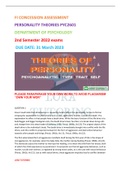Exam (elaborations)
FI CONCESSION ASSESSMENT PERSONALITY THEORIES PYC2601
- Institution
- University Of South Africa (Unisa)
FI CONCESSION ASSESSMENT PERSONALITY THEORIES PYC2601 DEPARTMENT OF PSYCHOLOGY 2nd Semester 2022 exams DUE DATE: 31 March 2023
[Show more]




